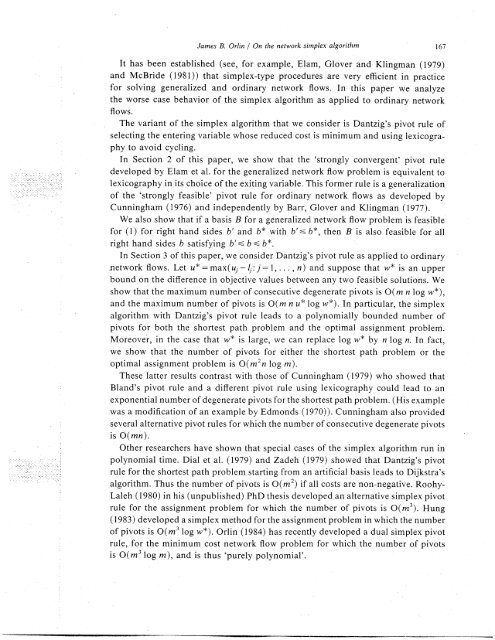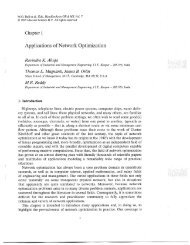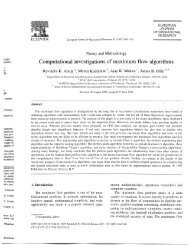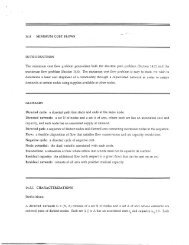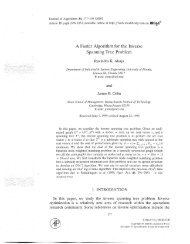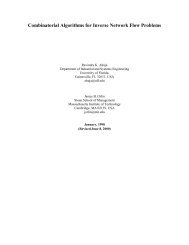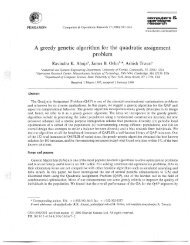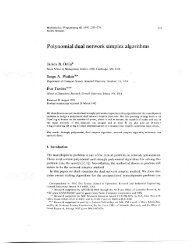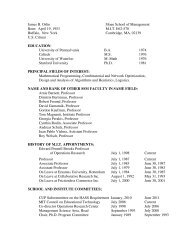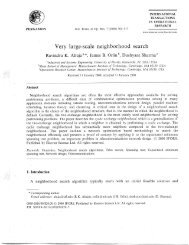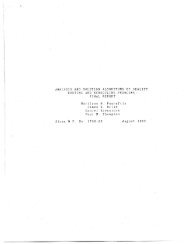ON THE SIMPLEX ALGORITHM FOR NETWORKS ... - James B. Orlin
ON THE SIMPLEX ALGORITHM FOR NETWORKS ... - James B. Orlin
ON THE SIMPLEX ALGORITHM FOR NETWORKS ... - James B. Orlin
You also want an ePaper? Increase the reach of your titles
YUMPU automatically turns print PDFs into web optimized ePapers that Google loves.
<strong>James</strong> B. <strong>Orlin</strong> / On the network simplex algorithm<br />
167<br />
L"" "' ' ` ' ' ' ' '''<br />
v<br />
''<br />
'''<br />
-··· ''<br />
1 ' · · -·.,<br />
c ·,·<br />
·<br />
It has been established (see, for example, Elam, Glover and Klingman (1979)<br />
and McBride (1981)) that simplex-type procedures are very efficient in practice<br />
for solving generalized and ordinary network flows. In this paper we analyze<br />
the worse case behavior of the simplex algorithm as applied to ordinary network<br />
flows.<br />
The variant of the simplex algorithm that we consider is Dantzig's pivot rule of<br />
selecting the entering variable whose reduced cost is minimum and using lexicography<br />
to avoid cycling.<br />
In Section 2 of this paper, we show that the 'strongly convergent' pivot rule<br />
developed by Elam et al. for the generalized network flow problem is equivalent to<br />
lexicography in its choice of the exiting variable. This former rule is a generalization<br />
of the 'strongly feasible' pivot rule for ordinary network flows as developed by<br />
Cunningham (1976) and independently by Barr, Glover and Klingman (1977).<br />
We also show that if a basis B for a generalized network flow problem is feasible<br />
for (1) for right hand sides b' and b with b'- b*, then B is also feasible for all<br />
right hand sides b satisfying b' s b -< b*.<br />
In Section 3 of this paper, we consider Dantzig's pivot rule as applied to ordinary<br />
network flows. Let u* = max(uj - : j = 1,..., n) and suppose that w* is an upper<br />
bound on the difference in objective values between any two feasible solutions. We<br />
show that the maximum number of consecutive degenerate pivots is O(m n log w*),<br />
and the maximum number of pivots is O(m n u* log w*). In particular, the simplex<br />
algorithm with Dantzig's pivot rule leads to a polynomially bounded number of<br />
pivots for both the shortest path problem and the optimal assignment problem.<br />
Moreover, in the case that w is large, we can replace log w* by n log n. In fact,<br />
we show that the number of pivots for either the shortest path problem or the<br />
optimal assignment problem is O(m 2 n log m).<br />
These latter results contrast with those of Cunningham (1979) who showed that<br />
Bland's pivot rule and a different pivot rule using lexicography could lead to an<br />
exponential number of degenerate pivots for the shortest path problem. (His example<br />
was a modification of an example by Edmonds (1970)). Cunningham also provided<br />
several alternative pivot rules for which the number of consecutive degenerate pivots<br />
is O(mn).<br />
Other researchers have shown that special cases of the simplex algorithm run in<br />
polynomial time. Dial et al. (1979) and Zadeh (1979) showed that Dantzig's pivot<br />
rule for the shortest path problem starting from an artificial basis leads to Dijkstra's<br />
algorithm. Thus the number of pivots is O(m 2 ) if all costs are non-negative. Roohy-<br />
Laleh (1980) in his (unpublished) PhD thesis developed an alternative simplex pivot<br />
rule for the assignment problem for which the number of pivots is O(m 3 ). Hung<br />
(1983) developed a simplex method for the assignment problem in which the number<br />
of pivots is O(m 3 log w*). <strong>Orlin</strong> (1984) has recently developed a dual simplex pivot<br />
rule for the minimum cost network flow problem for which the number of piv ots<br />
is O(m 3 log m), and is thus 'purely polynomial'.<br />
--PlxnsaasrueqrraasPldg**lllllsr*%IRI* Ir*lrcrr-, -- L-----LLI-·I·LYI·^·)(-··IC --·L -lil _-- -il I - _-: -_ll--11IILIII


